现在完成时课堂学案
- 格式:doc
- 大小:776.00 KB
- 文档页数:6
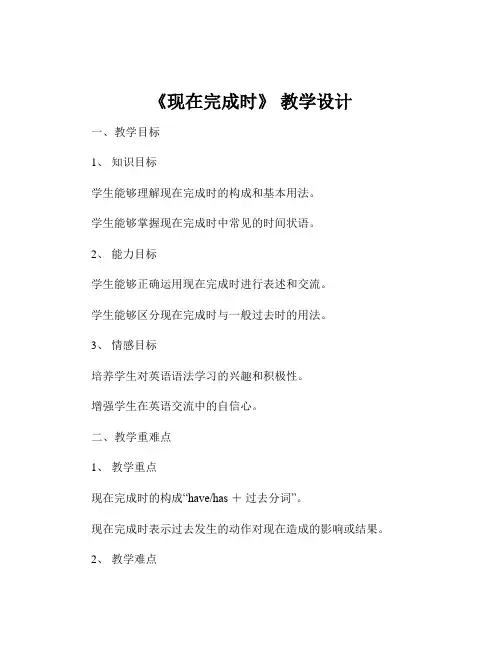
《现在完成时》教学设计一、教学目标1、知识目标学生能够理解现在完成时的构成和基本用法。
学生能够掌握现在完成时中常见的时间状语。
2、能力目标学生能够正确运用现在完成时进行表述和交流。
学生能够区分现在完成时与一般过去时的用法。
3、情感目标培养学生对英语语法学习的兴趣和积极性。
增强学生在英语交流中的自信心。
二、教学重难点1、教学重点现在完成时的构成“have/has +过去分词”。
现在完成时表示过去发生的动作对现在造成的影响或结果。
2、教学难点现在完成时与一般过去时的区别和联系。
现在完成时中延续性动词和非延续性动词的使用。
三、教学方法讲授法、练习法、情景教学法、小组合作法四、教学过程1、导入(5 分钟)通过播放一段简短的英语视频,内容为两个人谈论旅行经历。
引导学生注意视频中人物的表述方式,特别是关于过去的经历以及对现在的影响。
提问学生在视频中听到了哪些关于过去经历的表述,从而引出本节课的主题——现在完成时。
2、知识讲解(15 分钟)(1)展示现在完成时的构成“have/has +过去分词”,并通过例句进行解释。
例如:“I have eaten breakfast” “He has finished his homework”(2)讲解现在完成时的基本用法,即表示过去发生的动作对现在造成的影响或结果。
举例说明,如:“I'm so tired I have been working all day” (强调因为一整天都在工作,所以现在很累。
)(3)介绍现在完成时中常见的时间状语,如“already”“yet”“just”“ever”“never”“for +时间段”“since +时间点”等,并通过例句让学生理解其用法。
3、对比讲解(10 分钟)将现在完成时与一般过去时进行对比,通过表格形式呈现两者在构成、时间状语、用法等方面的差异。
并通过例句让学生体会两者的不同,如:“I ate breakfast at 7 o'clock this morning” (一般过去时,强调过去某个时间点发生的动作)“I have eaten breakfast” (现在完成时,强调吃过早餐对现在的影响,比如现在不饿了。
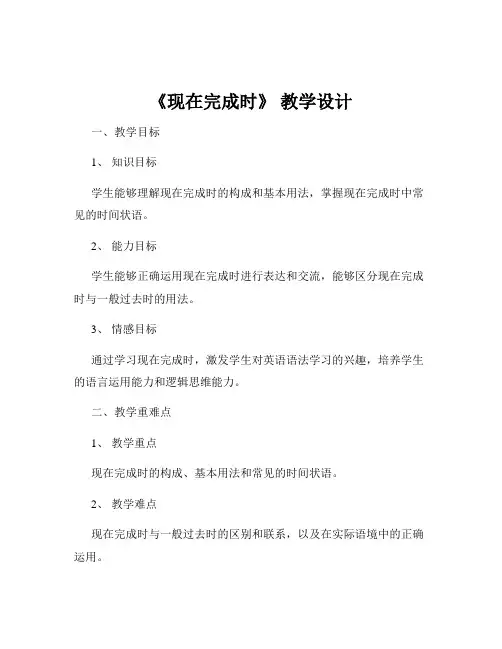
《现在完成时》教学设计一、教学目标1、知识目标学生能够理解现在完成时的构成和基本用法,掌握现在完成时中常见的时间状语。
2、能力目标学生能够正确运用现在完成时进行表达和交流,能够区分现在完成时与一般过去时的用法。
3、情感目标通过学习现在完成时,激发学生对英语语法学习的兴趣,培养学生的语言运用能力和逻辑思维能力。
二、教学重难点1、教学重点现在完成时的构成、基本用法和常见的时间状语。
2、教学难点现在完成时与一般过去时的区别和联系,以及在实际语境中的正确运用。
三、教学方法1、讲授法通过讲解现在完成时的概念、构成和用法,让学生对现在完成时有初步的了解。
2、练习法通过课堂练习和课后作业,让学生巩固所学知识,提高运用现在完成时的能力。
3、情境教学法创设真实的语言情境,让学生在情境中感受和运用现在完成时,提高语言的实际运用能力。
4、对比教学法将现在完成时与一般过去时进行对比,帮助学生理解两者的区别和联系,加深对现在完成时的理解。
四、教学过程1、导入(5 分钟)通过播放一段英语视频或讲述一个英语故事,引出与现在完成时相关的句子,如:“I have seen this movie before” “He has lived in this city for five years” 让学生初步感受现在完成时的用法,从而引出本节课的主题——现在完成时。
2、知识讲解(20 分钟)(1)现在完成时的构成现在完成时的构成是“have/has +过去分词”。
其中,have 用于第一人称(I、we)、第二人称(you)以及复数主语(they、the boys 等);has 用于第三人称单数主语(he、she、it、John 等)。
例如:I have finished my homeworkShe has gone to Beijing(2)现在完成时的基本用法①表示过去发生的动作对现在造成的影响或结果。
例如:I have lost my key (结果是现在找不到钥匙了)②表示过去已经开始,持续到现在的动作或状态。
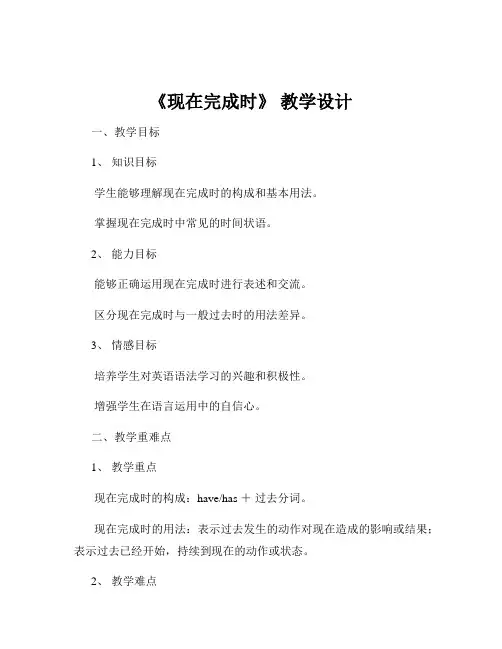
《现在完成时》教学设计一、教学目标1、知识目标学生能够理解现在完成时的构成和基本用法。
掌握现在完成时中常见的时间状语。
2、能力目标能够正确运用现在完成时进行表述和交流。
区分现在完成时与一般过去时的用法差异。
3、情感目标培养学生对英语语法学习的兴趣和积极性。
增强学生在语言运用中的自信心。
二、教学重难点1、教学重点现在完成时的构成:have/has +过去分词。
现在完成时的用法:表示过去发生的动作对现在造成的影响或结果;表示过去已经开始,持续到现在的动作或状态。
2、教学难点现在完成时与一般过去时的区别。
瞬间动词在现在完成时中的使用及转换。
三、教学方法1、讲授法通过讲解现在完成时的概念、构成和用法,让学生对该语法有初步的了解。
2、练习法设计各种形式的练习题,如填空、选择、造句等,让学生在实践中巩固所学知识。
3、对比法将现在完成时与一般过去时进行对比,帮助学生清晰地理解两者的差异。
4、情景教学法创设真实的语言情景,让学生在具体的情境中运用现在完成时进行交流。
四、教学过程1、导入(5 分钟)通过展示一些图片或讲述一个小故事,引出与现在完成时相关的句子,如:“I have already eaten breakfast” “She has just finished herhomework” 让学生观察这些句子的特点,引发他们的思考,从而导入新课。
2、知识讲解(15 分钟)构成:详细讲解现在完成时的构成“have/has +过去分词”,举例说明主语是第三人称单数时用“has”,其他人称用“have”。
同时,展示一些动词的过去分词形式,让学生进行记忆和练习。
用法:表示过去发生的动作对现在造成的影响或结果,如:“I have lostmy key I can't enter the room”表示过去已经开始,持续到现在的动作或状态,如:“I have lived here for five years”时间状语:介绍现在完成时常见的时间状语,如“already, yet, just, ever, never, for, since”等,并通过例句让学生理解它们在句子中的使用。
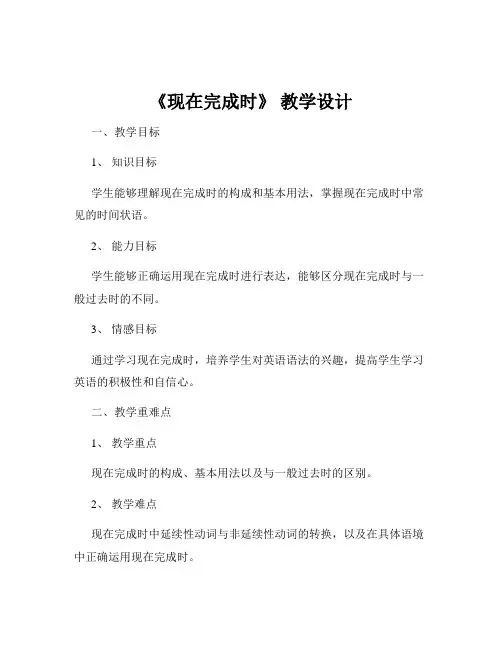
《现在完成时》教学设计一、教学目标1、知识目标学生能够理解现在完成时的构成和基本用法,掌握现在完成时中常见的时间状语。
2、能力目标学生能够正确运用现在完成时进行表达,能够区分现在完成时与一般过去时的不同。
3、情感目标通过学习现在完成时,培养学生对英语语法的兴趣,提高学生学习英语的积极性和自信心。
二、教学重难点1、教学重点现在完成时的构成、基本用法以及与一般过去时的区别。
2、教学难点现在完成时中延续性动词与非延续性动词的转换,以及在具体语境中正确运用现在完成时。
三、教学方法讲授法、练习法、情景教学法、小组合作法四、教学过程1、导入(5 分钟)通过播放一段英文电影片段,其中包含现在完成时的句子,如:“I have seen this movie before” 然后提问学生是否能理解这些句子的意思,从而引出本节课的主题——现在完成时。
2、讲解现在完成时的构成(10 分钟)在黑板上写出现在完成时的构成:主语+ have/has +过去分词。
向学生解释 have/has 的用法,当主语是第三人称单数时用 has,其余情况用 have。
然后通过举例让学生理解过去分词的变化规则,如:work worked,play played,see seen 等。
3、讲解现在完成时的基本用法(15 分钟)(1)表示过去发生的动作对现在造成的影响或结果。
例如:“I have lost my key I can't enter the room” 强调“丢钥匙”这个过去的动作导致了现在“进不了房间”的结果。
(2)表示过去已经开始,持续到现在的动作或状态。
例如:“I have lived here for five years” 说明“住在这里”的动作从过去开始一直持续到现在。
4、现在完成时中常见的时间状语(10 分钟)向学生介绍现在完成时中常见的时间状语,如:already(已经)、yet(还,尚未)、just(刚刚)、ever(曾经)、never(从不)、for+时间段、since +时间点等。
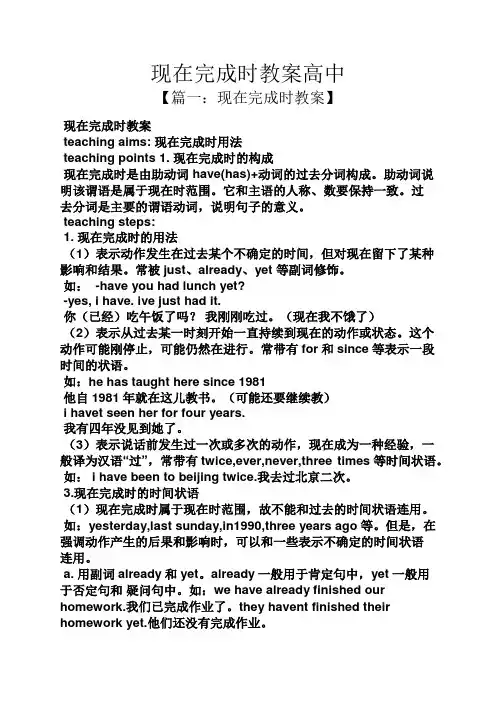
现在完成时教案高中【篇一:现在完成时教案】现在完成时教案teaching aims: 现在完成时用法teaching points 1. 现在完成时的构成现在完成时是由助动词 have(has)+动词的过去分词构成。
助动词说明该谓语是属于现在时范围。
它和主语的人称、数要保持一致。
过去分词是主要的谓语动词,说明句子的意义。
teaching steps:1. 现在完成时的用法(1)表示动作发生在过去某个不确定的时间,但对现在留下了某种影响和结果。
常被just、already、yet 等副词修饰。
如: -have you had lunch yet?-yes, i have. ive just had it.你(已经)吃午饭了吗?我刚刚吃过。
(现在我不饿了)(2)表示从过去某一时刻开始一直持续到现在的动作或状态。
这个动作可能刚停止,可能仍然在进行。
常带有for和since等表示一段时间的状语。
如:he has taught here since 1981他自1981年就在这儿教书。
(可能还要继续教)i havet seen her for four years.我有四年没见到她了。
(3)表示说话前发生过一次或多次的动作,现在成为一种经验,一般译为汉语“过”,常带有twice,ever,never,three times等时间状语。
如: i have been to beijing twice.我去过北京二次。
3.现在完成时的时间状语(1)现在完成时属于现在时范围,故不能和过去的时间状语连用。
如:yesterday,last sunday,in1990,three years ago等。
但是,在强调动作产生的后果和影响时,可以和一些表示不确定的时间状语连用。
a. 用副词already和yet。
already一般用于肯定句中,yet一般用于否定句和疑问句中。
如:we have already finished our homework.我们已完成作业了。
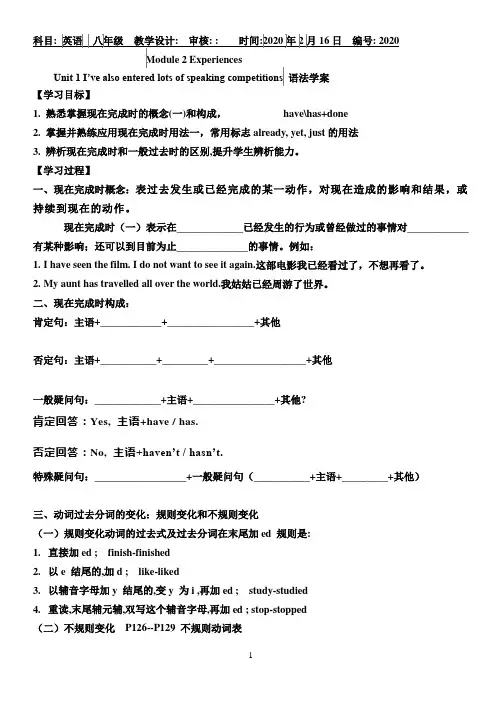
【学习目标】1. 熟悉掌握现在完成时的概念(一)和构成,have\has+done2. 掌握并熟练应用现在完成时用法一,常用标志already, yet, just的用法3. 辨析现在完成时和一般过去时的区别,提升学生辨析能力。
【学习过程】一、现在完成时概念:表过去发生或已经完成的某一动作,对现在造成的影响和结果,或持续到现在的动作。
现在完成时(一)表示在_____________已经发生的行为或曾经做过的事情对____________有某种影响;还可以到目前为止______________的事情。
例如:1.I have seen the film. I do not want to see it again.这部电影我已经看过了,不想再看了。
2.My aunt has travelled all over the world.我姑姑已经周游了世界。
二、现在完成时构成:肯定句:主语+____________+_________________+其他否定句:主语+___________+_________+__________________+其他一般疑问句:_____________+主语+________________+其他?肯定回答:Yes, 主语+have / has.否定回答:No, 主语+haven’t / hasn’t.特殊疑问句:__________________+一般疑问句(___________+主语+_________+其他)三、动词过去分词的变化:规则变化和不规则变化(一)规则变化动词的过去式及过去分词在末尾加ed 规则是:1.直接加ed ; finish-finished2.以e 结尾的,加d ; like-liked3.以辅音字母加y 结尾的,变y 为i ,再加ed ; study-studied4.重读,末尾辅元辅,双写这个辅音字母,再加ed ; stop-stopped(二)不规则变化P126--P129 不规则动词表巧记不规则动词的过去式、过去分词1)AAA型: read—read—read, put—put—put2)AAB型: beat—beat—beaten3)ABA型: come—came—come, run—ran—run4)ABB型: hear—heard—heard, make—made—madesend—sent—sent, sell—sold—sold find—found—found, win—won—won5)ABC型: do—did—done, go—went—gone see—saw—seen, eat—ate—eaten;fly—flew—flown, swim—swam—swum四、现在完成时(一)的常用标志:1. 现在完成时往往同表示不确定的时间状语连用already(肯定), yet(否定,疑问), just,before, recently探究already,yet.just, 的用法just “刚刚”,already “已经”,两者都用于肯定句中,一般置于have/has之后。
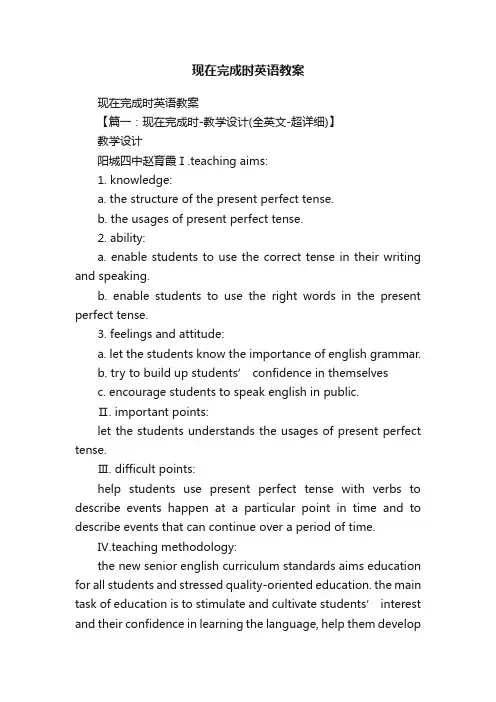
现在完成时英语教案现在完成时英语教案【篇一:现在完成时-教学设计(全英文-超详细)】教学设计阳城四中赵育霞Ⅰ.teaching aims:1. knowledge:a. the structure of the present perfect tense.b. the usages of present perfect tense.2. ability:a. enable students to use the correct tense in their writing and speaking.b. enable students to use the right words in the present perfect tense.3. feelings and attitude:a. let the students know the importance of english grammar.b. try to buil d up students’ confidence in themselvesc. encourage students to speak english in public.Ⅱ. important points:let the students understands the usages of present perfect tense.Ⅲ. difficult points:help students use present perfect tense with verbs to describe events happen at a particular point in time and to describe events that can continue over a period of time.Ⅳ.teaching methodology:the new senior english curriculum standards aims education for all students and stressed quality-oriented education. the main task of education is to stimulate and cultivate students’ interest and their confidence in learning the language, help them developgood learning habits and form effective learning strategies, facilitate autonomy and cooperative spirit in learning ; enable students to master basic english language knowledge and skills in listening, speaking, reading and writing.according to the new standards, the students should be the center of the class and the teacher serves as a controller, organizer, participant, or resource-provider most times. considered with the characteristic of the teaching contents and the learners, i will apply explanation and practicing in my teaching. most of the usages will be summarized by students themselves.Ⅴ.teaching tool: pptⅥ. teaching steps:step1. revision lead-in (2min)1.invite students to read sentences using present perfecttense they have found before the class.s1: i’ve seen quite a lot of china.s2: i’ve visited some beautiful cities.s3: they have just completed it.s4: ...2. show some sentences on the board.1). they have put up a lot of high-rise buildings recently.2). my wife’s just bought a beautiful dress from one of the shops there.3). it’s got some really pretty parks.4). a friend’s told me about a nice f ish restaurant.step2. present perfect tense1. the structure of present perfect tense.after reading these sentences, ask students to find the structure of these sentences with present perfect tense.1). have/has+done2). have/has+not+done3). have/has+been+done2. the usage of present perfect tenseplay the flash (a pig and his mom), and tell students to recall the main usages of this tense.q: the story happens in the past, but the pig and his mom use present perfect tense to describe it, can you tell me the reason? draw a time line on the blackboard:1). usage1: “完成用法”①强调过去发生的动作对现在造成的影响或结果,常用状语有:already, yet, never, ever, just, before ...e.g.1. i have just cleaned my hands.e.g.2. i have lost my wallet.e.g.3. i have already finished my homework. i am free.②show the following sentences and have students summarize the difference between the past simple tense and present perfect tense.he has already read that book. (说明他现在知道那本书的内容) he read that book last year. (只说明他去年读过那本书 )he has gone to america. (他现在不在此地, 在美国)he went to america eight weeks ago. (只说明他去过美国)summary:一般过去时表示过去发生的动作或存在的状态,与现在情况无关,常用时间状语为yesterday, last year, in the past等,而现在完成时与现在有关。
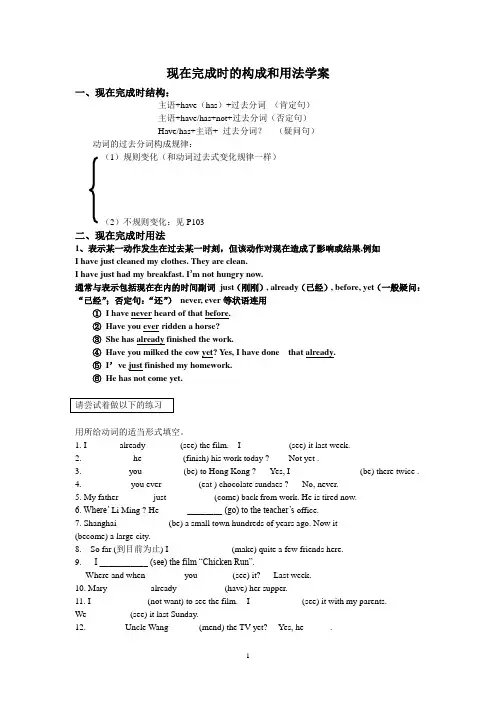
现在完成时的构成和用法学案一、现在完成时结构:主语+have(has)+过去分词(肯定句)主语+have/has+not+过去分词(否定句)Have/has+主语+ 过去分词?(疑问句)动词的过去分词构成规律:(1)规则变化(和动词过去式变化规律一样)(2)不规则变化:见P103二、现在完成时用法1、表示某一动作发生在过去某一时刻,但该动作对现在造成了影响或结果,例如I have just cleaned my clothes. They are clean.I have just had my breakfast. I’m not hungry now.通常与表示包括现在在内的时间副词just(刚刚), already(已经), before, yet(一般疑问:“已经”;否定句:“还”)never, ever等状语连用①I have never heard of that before.②Have you ever ridden a horse?③She has already finished the work.④Have you milked the cow yet? Y es, I have done that already.⑤I’ve just finished my homework.⑥He has not come yet.用所给动词的适当形式填空。
1. I_______ already _______ (see) the film. I __________ (see) it last week.2. ----- _______ he _________(finish) his work today ? ------Not yet .3. -----_______you _________(be) to Hong Kong ? ----Yes, I _______________ (be) there twice .4. -----_______ you ever ________(eat ) chocolate sundaes ? ----No, never.5. My father _______ just __________ (come) back from work. He is tired now.6. Where’ Li Ming ? He ______________ (go) to the teacher’s office.7. Shanghai ___________ (be) a small town hundreds of years ago. Now it ____________ (become) a large city.8. So far (到目前为止) I ______________(make) quite a few friends here.9. --- I ___________ (see) the film “Chicken Run”.--- Where and when ________ you _______ (see) it? --- Last week.10. Mary _________ already __________ (have) her supper.11. I ____________ (not want) to see the film. I ___________ (see) it with my parents.We _________ (see) it last Sunday.12. ---______ Uncle Wang ______ (mend) the TV yet? ---Yes, he______.---When _____ he _____ it? --- Yesterday.13. ______ you _______ (read) today’s newspaper yet?14 They _____ already______(do) their homework. But they don’t know what_______ (do) next.15. ---______ you ________ (see) the film last night?---No, I ___________ (see) it for several times.2、表示某一动作开始于过去某一时刻,一直延续到现在,或可能还要延续下去。
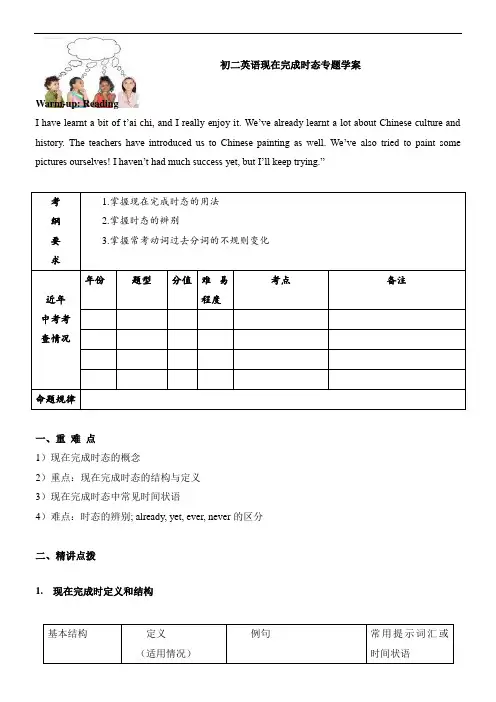
初二英语现在完成时态专题学案Warm-up: ReadingI have learnt a bit of t’ai chi, and I really enjoy it. We’ve already learnt a lot about Chinese culture and history. The teachers have introduced us to Chinese painting as well. We’ve also tried to paint some pictures ourselves! I haven’t had much success yet, but I’ll keep trying.”考纲要求1.掌握现在完成时态的用法2.掌握时态的辨别3.掌握常考动词过去分词的不规则变化近年中考考查情况年份题型分值难易程度考点备注命题规律一、重难点1)现在完成时态的概念2)重点:现在完成时态的结构与定义3)现在完成时态中常见时间状语4)难点:时态的辨别; already, yet, ever, never的区分二、精讲点拨1.现在完成时定义和结构基本结构定义(适用情况)例句常用提示词汇或时间状语PS: 1)当主语是第三人称单数时用has,其余人称用have.2)过去分词:规则动词的过去分词构成与动词过去式相同,不规则动词需要特殊记忆。
PS: 缩略形式:I have = I’ve you have = you’ve we have = we’vethey have = they’ve he has = he’s She has = she’sit has = it’s have not = haven’t has not = hasn’t【Ex2】按要求改写下列句子1. Peter has told me the news. (改为否定句)_________________________________________________________________2. Edwin and Alex have watched the football game. (改为一般疑问句并做肯定和否定回答)__________________________________________________________________________________________________________________________________3. Timmy hasn’t come here yet. (改为肯定句)_________________________________________________________________3.用法注意1)表示动作已完成、结束,但对现在有影响。
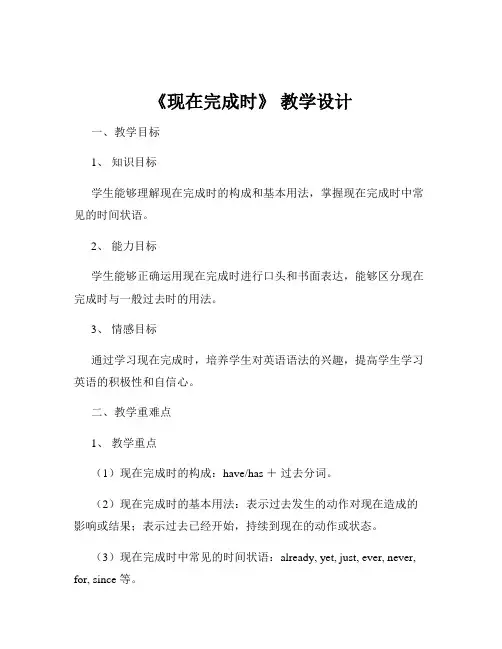
《现在完成时》教学设计一、教学目标1、知识目标学生能够理解现在完成时的构成和基本用法,掌握现在完成时中常见的时间状语。
2、能力目标学生能够正确运用现在完成时进行口头和书面表达,能够区分现在完成时与一般过去时的用法。
3、情感目标通过学习现在完成时,培养学生对英语语法的兴趣,提高学生学习英语的积极性和自信心。
二、教学重难点1、教学重点(1)现在完成时的构成:have/has +过去分词。
(2)现在完成时的基本用法:表示过去发生的动作对现在造成的影响或结果;表示过去已经开始,持续到现在的动作或状态。
(3)现在完成时中常见的时间状语:already, yet, just, ever, never, for, since 等。
2、教学难点(1)现在完成时与一般过去时的区别和联系。
(2)非延续性动词在现在完成时中的转换。
三、教学方法1、讲授法通过讲解现在完成时的构成、用法和时间状语,让学生对现在完成时有初步的了解。
2、练习法通过做练习题,让学生巩固所学的知识,加深对现在完成时的理解和运用。
3、情景教学法创设真实的语言情景,让学生在实际情境中运用现在完成时,提高学生的语言运用能力。
4、对比分析法对比现在完成时与一般过去时的用法,让学生更加清晰地理解两者的区别。
四、教学过程1、导入(5 分钟)通过播放一段英语电影片段或展示一组图片,引导学生观察并思考其中的动作发生的时间,从而引出现在完成时的概念。
例如,展示一张某人旅行的照片,问学生:Has he ever been to Beijing? 引导学生回答:Yes, he has 或 No, he hasn't2、知识讲解(15 分钟)(1)现在完成时的构成讲解现在完成时的构成:主语+have/has +过去分词。
举例说明:I have eaten breakfast He has finished his homework(2)现在完成时的基本用法①表示过去发生的动作对现在造成的影响或结果。

学案(七)时态现在完成时、过去完成时、将来完成时和现在完成进行时1.你已经浇过花了吗?______________________________________________________2.灿姐非常开心因为她儿子在比赛中得了第一名。
_____________________________________________________________________________________________________3.我已经完成了我的家庭作业。
__________________________________________________4.金先生已经在这住了5年了。
__________________________________________________5.在过去的十年间中国改变了很多。
______________________________________________6.他的父亲已经死了3年了。
_____________________________________________________7.这是第一次我看到如此多的钱。
________________________________________________8.这是我见过的最恐怖的电影。
__________________________________________________9.It was the second time that I _________________ (hurt) by his words.总结一:构成:_________________________________________用法:(1)_________________________________________________________________(2)___________________________________________________________________________________________________________________________________________(3)_________________________________________________________________________________________________________________________________________________________________________________________________________________(4)______________________________________________________________________(5)在以下几种句型中用现在完成时。
现在完成时教案教案:现在完成时教学目标:1. 理解现在完成时的用法,包括表达过去发生的动作对现在造成的影响或结果。
2. 学会使用现在完成时构建句子。
3. 运用现在完成时进行口语和写作练习。
教学步骤:步骤一:导入新知识1. 引入关于现在完成时的话题:请学生谈一谈自己的生活经历或者最近的活动。
2. 引导学生思考他们过去做过的事情对现在的影响:例如,他们是否学过某种乐器、参加过什么比赛或者旅行等等。
步骤二:介绍现在完成时1. 解释现在完成时的定义和用法:现在完成时用于表达过去发生的动作对现在造成的影响或结果。
2. 举例说明现在完成时的用法:例如,I have lived in Shanghai for ten years.(我在上海生活了十年了。
)步骤三:构建现在完成时的句子1. 解释现在完成时的构成:现在完成时由“have/has + 过去分词”构成。
2. 示范构建现在完成时的肯定句、否定句和疑问句,并提示学生注意动词过去分词的规则变化。
- 肯定句:主语 + have/has + 过去分词- 否定句:主语 + have/has + not + 过去分词- 疑问句:Have/Has + 主语 + 过去分词?步骤四:口语练习1. 让学生结对或小组,进行问答练习,用现在完成时回答以下问题:- Have you ever been to another country?- Have you ever tried a new sport/activity?- Have you ever met a famous person?步骤五:写作练习1. 让学生写一篇关于自己生活经历或最近活动的短文,使用现在完成时。
2. 学生可以包括以下内容:地方、事情或活动、时间等等。
扩展活动:1. 让学生阅读一篇使用现在完成时的文章,并回答相关问题。
2. 学生可以在小组中分享自己的写作,互相评价和提供建议。
教学评价:1. 教师观察学生在练习中的表现,特别是使用现在完成时构建句子的能力。
《现在完成时》教学设计一、教学目标1、知识目标学生能够理解现在完成时的构成和基本用法。
学生能够区分现在完成时与一般过去时的用法差异。
2、能力目标学生能够正确运用现在完成时进行口头和书面表达。
学生能够在语境中理解和运用现在完成时的相关句型。
3、情感目标培养学生对英语语法学习的兴趣和积极性。
增强学生在英语交流中的自信心。
二、教学重难点1、教学重点现在完成时的构成:have/has +过去分词。
现在完成时的基本用法:表示过去发生的动作对现在造成的影响或结果;表示过去已经开始,持续到现在的动作或状态。
2、教学难点现在完成时与一般过去时的用法辨析。
现在完成时中一些标志性的时间状语的理解和运用,如 already, yet, just, ever, never 等。
三、教学方法1、讲授法通过讲解现在完成时的构成和用法,让学生对这一语法有初步的认识。
2、练习法设计各种形式的练习题,如填空、选择、翻译等,让学生在实践中巩固所学知识。
3、情景教学法创设生动的情景,让学生在实际情境中感受和运用现在完成时。
4、对比分析法将现在完成时与一般过去时进行对比分析,帮助学生清晰地理解两者的区别。
四、教学过程1、导入(5 分钟)通过播放一段英语电影片段或展示一些有趣的图片,引导学生关注其中的英语表达,并提问:“Can you find some sentences that are different from the simple past tense?” 从而引出现在完成时。
2、知识讲解(15 分钟)展示现在完成时的构成:主语+ have/has +过去分词。
并举例说明,如:I have finished my homework He has gone to Beijing 讲解现在完成时的两种基本用法:表示过去发生的动作对现在造成的影响或结果。
例如:I have lost my key (结果是现在找不到钥匙了)表示过去已经开始,持续到现在的动作或状态。
现在完成时学案 (3) Pattern IV . Have you …before? 你以前…做过某事吗? Have you seen the movie before? Yes, I have . I have seen it before. I saw it a year ago. No, I haven’t . I have never seen it before. 替换词:meet (met , met ) him / her / Miss King / Mr Black eat (ate, eaten) beef / chicken / meat Written Exercise 书面练习 模仿例句写出答句。 Have you seen the movie before? (a year ago) Yes, I have . I have seen it before. I saw it a year ago. 1. Have you cooked meals before ? (two years ago) __________________________________________________________________ 2. Has he eaten meat before? ( ten years ago) __________________________________________________________________ 3. Have they learned Chinese before ? ( three months ago) __________________________________________________________________ 4. Has Tom washed clothes before? (two days ago) 5. Have you told them the news before ? ( a month ago) 归纳: before “以前”用在_________________中,可以单独使用,放在_________________。 ago ““以前”,用在_________________中 ,不可单独使用,放在表示时间____________之_____。 Pattern V. 1. How long have you …? 你做某事多久了? I have …for two days / since two days ago. 替换词: lived in Jinan ; watched TV ; washed clothes ;laughed ; cried; worked here ; been ill two weeks ; two months ; two years ; 2. How long has he / she…? 他/她做某事多久了? He / She has …. Written Exercise书面练习 A: 模仿例句回答问题 How long have you done your homework? (3 hours) I have done homework for 3 hours . I have done homework since 3 hours ago. 1. How long have you worked here ? ( 20 years ) ___________________________________________________________________________ 2. How long have they lived in Beijing? (6 years) ___________________________________________________________________________ 3. How long has she been ill ? ( 2 days ) ___________________________________________________________________________ 4. How long has he slept ? ( 8 hours) 5. How long have you taught Chinese ? (20 years) B. 模仿例句回答问题 How long have you been in Jinan? ( was, 4 years old. ) I have been in Jinan since I was 4 years old. 1. How long has Lucy been in China? (was; 5 years old.) __________________________________________________________________________ 2. How long have you been a teacher ? ( was , 20 years old ) __________________________________________________________________________ 3.How long have you lived in Jinan ? (was, 3 years old ) __________________________________________________________________________ 4.How long has she worked in the factory ? ( was , 18 years old ) 5. How long have they learned to dance ? (were , 14 years old) C: 用for 或since 填空: 1. He has worked________ two days. 2. I have been here ________ 1999. 3. They have lived _______ ten years. 4..I have taught English _________ 22 years. 5. They have learned math _________last year. 6. He has been a teacher _________ 20 years ago. 7.I have lived here ________ I was very young. 8. His sister has learnt French_______ he got to France..
《现在完成时》教学设计一、教学目标1、知识目标学生能够理解现在完成时的构成和基本用法。
学生能够区分现在完成时与一般过去时的用法差异。
2、能力目标学生能够正确运用现在完成时进行表述和交流。
学生能够根据语境选择合适的时态。
3、情感目标培养学生对英语语法学习的兴趣和积极性。
增强学生在语言运用中的自信心。
二、教学重难点1、教学重点现在完成时的构成“have/has +过去分词”。
现在完成时中标志词的使用,如 already, yet, just, ever, never 等。
现在完成时表示过去发生的动作对现在造成的影响或结果。
2、教学难点现在完成时与一般过去时在语境中的正确运用。
理解现在完成时中延续性动词与非延续性动词的转换。
三、教学方法1、讲授法讲解现在完成时的概念、构成和用法,让学生对其有初步的了解。
2、比较法通过对比现在完成时与一般过去时的用法,帮助学生更清晰地理解两者的差异。
3、练习法安排多种形式的练习,如填空、选择、造句等,让学生在实践中巩固所学知识。
4、情景教学法创设真实的语言情境,让学生在情境中感受和运用现在完成时。
四、教学过程1、导入(5 分钟)通过播放一段有趣的英语短片或讲述一个小故事,引入与现在完成时相关的话题。
例如:“I have just watched a great movie What about you?”引导学生思考句子中“have just watched”的用法。
2、知识讲解(15 分钟)呈现现在完成时的构成“have/has+过去分词”,并举例说明。
讲解现在完成时的基本用法:表示过去发生的动作对现在造成的影响或结果,如:“I have lostmy key I can't enter the room”表示过去已经开始,持续到现在的动作或状态,如:“I have lived here for five years”强调现在完成时的标志词:already(已经,用于肯定句)、yet (还,用于否定句和疑问句)、just(刚刚)、ever(曾经)、never(从未)等,并通过例句让学生理解其用法。
现在完成时课堂学案 -CAL-FENGHAI-(2020YEAR-YICAI)_JINGBIAN 现在完成时态 学案 The Present Perfect Tense 1。表过去发生的某一动作对现在造成的影响或结果,例如 I have just had my breakfast. (对现在的影响:不饿) 通常与表示包括现在在内的时间副词 already , never, ever, just, yet等状语连用 ①She has already finished the work. ② I have never heard of that before. ③ Have you ever ridden a horse?
④ I’ve just finished my homework. ⑤Have you milked the cow yet Yes, I have done that already. ⑥He has not come yet. 注意点一: 现在完成时与一般过去时的用法比较 现在完成时不能和表示过去的时间状语连用。 如:yesterday, last night, two weeks ago,in1998,just now等 试比较: The plane has arrived . 飞机已经来了。(说明现在的情况:飞机在这儿) The plane arrived a quarter ago. 飞机是一刻中以前来的。(强调动作发生的时间在过去) Put the following sentences into English. 1. A: 火车已经开走了. B: 什么时候开走的
A: 半个小时之前开走的. 2. A: 这本书我已经买了两年了. B: 你在哪儿买的
A: 在我老家买的. 3. A: 你看过这部电影吗 4. B: 看过. A: 什么时候看的. B: 上周星期天看的. 2。表示过去已经开始,持续到现在的动作或状态.通常和 for(段时间), since(点时间)以及 so far, by now, these days, in the last ten years 等连用。 注意点二、非延续性动词不能与时间段for, since, how long连用,要转换成为意思与它相近的词。 1.I have borrowed the book for 2 weeks. ( ) 2.The film has begun for 5 minutes.( ) 3. 这辆自行车我买了两年了。 I’ve _____ the bike _____ two years. 4. He left Nanjing two years ago. He _____ _____ _____ _____ Nanjing for two years. 5. The monkey died last month. The monkey _____ _____ _____ for a month. 6. A: Hong long _____ you ____ ( ) B: Two weeks. A.did,get ill B. have,fallen ill C. were,ill D. have,been ill 注意要点三:have been in, have been to 与have gone to 的用法 练习:用have(has) been 或have(has) gone 填空 A: Where __1__ Li Fei __1__ B: He __2__ to Hainan Island. A: How long __3__ he __3___ there? B: He ___4__ there for three days. A: When will he come back , do you know? B: I’m afraid he won’t come back recently. A: Could you tell me the way to Hainan Island
B: Sorry, I __5__ never __5__ there. A: How many times __6__ Li Fei __6___ to that place? B: He __7__ there only once. 用括号中所给的动词的适当形式完成下列句子。 1. Mary _______(lose) her pen. ______ you ______ (see) it here and there? 2. ______ you ______ (find) your watch yet?
3. ---Are you thirsty ---NO, I ______ just _______ (have) some orange. 4. We ________already ______ (return) the book. 5. ______ they _____ (build) a new school in the village? 6. ---Has Tom taught you English? ---Yes, he ______ (teach) us English for two years. 7. I ______(not finish) my homework yet. Can you help me? 8. What ______ they _____ (do) with the newspaper They have read them. 9. --- The door is open. Who ______ (open) it Do you know --- Sorry, I don’t know. 10. My father _____ (read) the novel twice. 11. Wu Dong _____(be) a soldier for one year. 12. The students ______(study) in the middle school since last month. 13. How long ______ you ______(know) him? 14. Mike ______ (make) quite a few friends since he came to China. 15. I _____(give) my friend a nice book recently. 16. Li Ping and Wu Dong ______(see) the old man three times. 17. _____ she ever _____(teach) you English? 18. These children _____ (stay) in the park for two hours.
现在完成时直击中考题 选择填空。 1.I_______ a letter from him since he left.(天津市) A.didn't receive B.haven't got C.didn't have D.haven't heard 2.—Where have you _______ these days —I have to ______ Dazhu with my friends.(重庆市) A.been;gone B.been;been C.gone;been D.gone;gone 3.How long have you _______ this book(哈尔滨市) A.bought B.borrowed C.had D.lent 4.—Where's Peter —He _______ to Nanjing.(沈阳市) A.is going B.has been C.has gone D.went 5.You've never seen such a wonderful film before,_______ (河北省) A.haven't you B.have you C.do you D.don't you
6.We have lived here _______ five years ago.(河南省) A.when B.since C.before D.after 7.—I have watched the game. —When you _______ it(长沙市) A.have;watched B.do;watch C.did;watch D.will;watch 8.—How do you like Beijing,Mr Black —Oh,I _______ such a beautiful city.(江西省) A.don't visit B.didn't visit C.haven't visited D.hadn't visited 9.The old people _______ lonely at all since we began to visit them once a week.(广州市)
A.don't feel B.hasn't felt C.haven't felt D.didn't feel 10.My grandfather_______ in the small town all his life.He always says he likes the town.(四川省)
A.lived B.have lived C.has lived D.is living 11.Miss Brown _______ to the Great Wall twice.(贵阳市) A.have been B.has been C.have gone D.has gone 12.His brother has been to Stone Forest twice _______ he came to Yunnan.(昆明市)
A.after B.before C.since D.for 13.His grandpa _______ for two years.(广西) A.was died B.has been dead C.was dead D.has died 14.—Have you ever_______ to Haikou —Yes,I_______ there with my family last August.(海南省) A.gone;went B.been;went